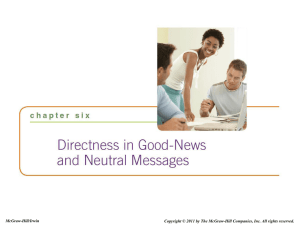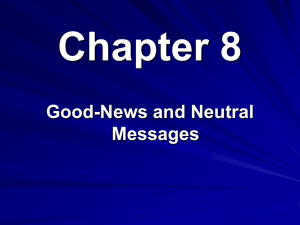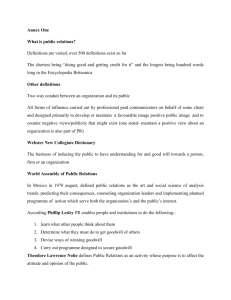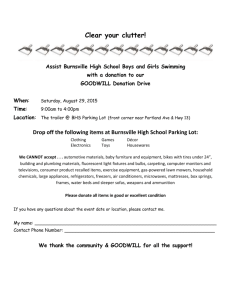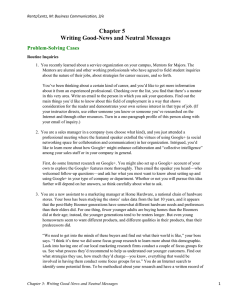Writing Routine, Good-News and Goodwill Messages
advertisement
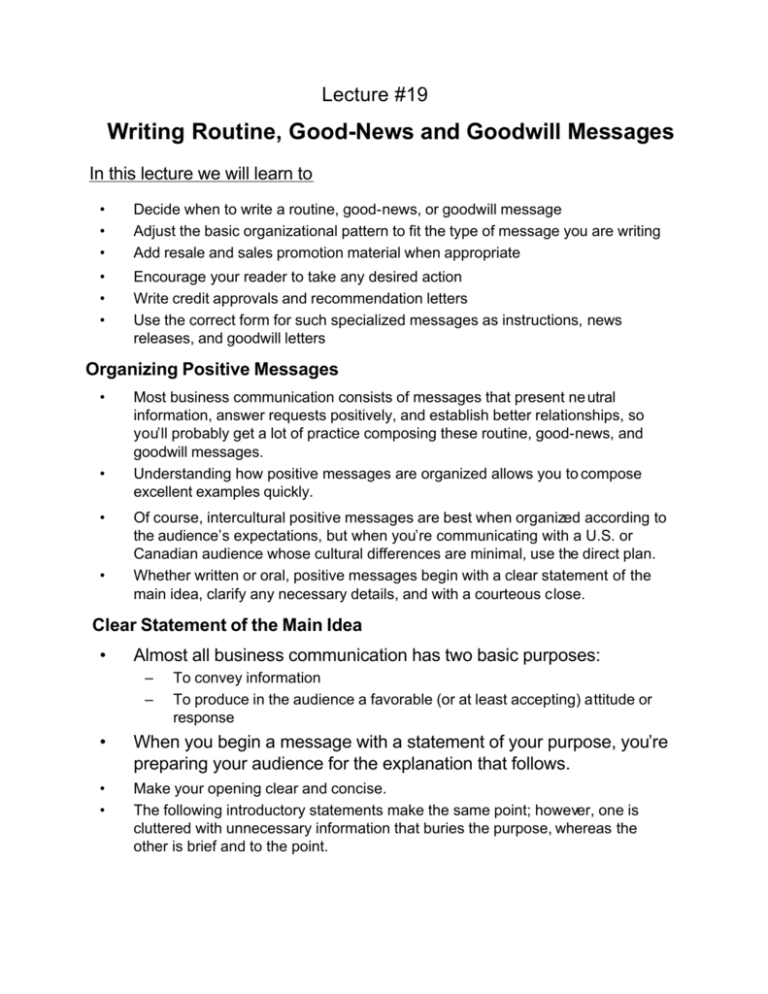
Lecture #19 Writing Routine, Good-News and Goodwill Messages In this lecture we will learn to • • • Decide when to write a routine, good-news, or goodwill message Adjust the basic organizational pattern to fit the type of message you are writing Add resale and sales promotion material when appropriate • • • Encourage your reader to take any desired action Write credit approvals and recommendation letters Use the correct form for such specialized messages as instructions, news releases, and goodwill letters Organizing Positive Messages • • • • Most business communication consists of messages that present ne utral information, answer requests positively, and establish better relationships, so you’ll probably get a lot of practice composing these routine, good-news, and goodwill messages. Understanding how positive messages are organized allows you to compose excellent examples quickly. Of course, intercultural positive messages are best when organized according to the audience’s expectations, but when you’re communicating with a U.S. or Canadian audience whose cultural differences are minimal, use the direct plan. Whether written or oral, positive messages begin with a clear statement of the main idea, clarify any necessary details, and with a courteous close. Clear Statement of the Main Idea • Almost all business communication has two basic purposes: – – To convey information To produce in the audience a favorable (or at least accepting) attitude or response • When you begin a message with a statement of your purpose, you’re preparing your audience for the explanation that follows. • • Make your opening clear and concise. The following introductory statements make the same point; however, one is cluttered with unnecessary information that buries the purpose, whereas the other is brief and to the point. Instead of this Write this I am pleased to inform you that after deliberating the matter carefully, our personnel committee has recommended you for appointment as a staff accountant. You’ve been selected to join our firm as a staff accountant, beginning March 20. Necessary Details • The middle part is typically the longest section of a routine, good-news, or goodwill message. • Your reason for communicating can usually be expressed in a sentence or two, but you’ll need more spaces or time to explain your point completely so that your audience will have no confusion or lingering doubt. • The task of providing necessary details is the easiest when you’re responding to a series of questions. • You can simply answer them in order, possibly in a numbered sequence. • • • • In addition to providing details in the middle section, maintain the supportive tone established at the beginning. When a routine message must convey mildly disappointing information, put the negative answer into as favorable context as possible. Instead of this Write this No, we no longer carry the Sportsgirl line of sweaters. The new Olympic line has replaced the Sportsgirl sweaters that you asked about. Olympic features a wider range of colors and sizes more contemporary styling. A bluntly negative explanation was replaced with a more complete description that emphasized how the audience could benefit from the change. Be careful, though: You can use negative information in this type of message only if you’re reasonably sure the audience will respond positively to your message. Courteous Close • • Your message is most likely to succeed if your audience is left with the feeling that you have their personal welfare in mind. In addition, if follow-up action is required, clearly state who will do what next. Acknowledging Orders • An order acknowledgement is unnecessary if the products are being shipped or the services will be provided immediately. • Acknowledgements are appropriate for large orders, first orders, and orders that cannot be filled right away. • • • The first paragraph states the good news: The order is being processed and the merchandise is on its way. The middle section demonstrates the professionalism of your firm with a clear, accurate summary of the transaction (when the delivery may be expected; the cost of the merchandise, shipping and taxes; any problems that might have arisen; and perhaps your credit terms). An order acknowledgement frequently does a bit of selling in the middle or closing section. Resale information bolsters the customer’s confidence by pointing out the good points of a product or a company by explaining how those good points will benefit the customer. Sales promotion – takes advantage of the customer’s obvious interest in your products. Sending along brochures or order blanks makes an additional purchase easier. Effective resale and sales promotion materials demonstrate the “you” attitude. • For example: • • • • Message Explanation You’ll receive your Span-aVision videocassette recorder in just over two weeks. The main message is stated clearly right at the start. Message Explanation Because you live in Massachusetts,you’re exempt from the Illinois sales tax. So I’m enclosing a check for $26.15, the amount of the sales tax that you included in your payment. The middle section conveys specific details about the order. Message Explanation Mr. Harmon, you’re going to enjoy you’re new VCR day after day. It’s quite versatile, and to make it even more so, you might want to add a remote-control device. Wired and wireless models are pictured in the enclosed brochure Resale and sales promotion build on the customer’s goodwill toward the product and the company. The customer’s name is mentioned as in a personal conversation, to increase the feeling of friendliness. Message Explanation When your new VCR arrives, spend a few minutes with the user’s manual. If you have any questions, call toll-free 1-800-441-6446 from 9:00 a.m. to 6:00 p.m. weekdays (Central Standard Time). One of our expert staff members will be happy to help you. In closing, the writer offers friendly accessible help. Replying to Requests for Information and Action • • • • • • • Any request is important to the person making it, whether inside or outside the organization. That person's opinion of your company, your products, your department, and you you yourself will be influenced by how promptly, graciously, and thoroughly the request is handled. Admittedly, complying with a request isn’t always easy. The information may not be immediately at hand, and decisions to take some action must often be made at a higher level. Because a letter written on letterhead stationery is legally binding, plan your response carefully. Companies usually develop form responses to handle repetitive queries that are often similar. Although form responses are often criticized as being cold and impersonal, much time and thought may go into wording them, and computers permit personalization and the mixing of paragraphs. Replying to Requests for Information and Action • • Companies usually develop form responses to handle repetitive queries that are often similar. Although form responses are often criticized as being cold and impersonal, much time and thought may go into wording them, and computers permit personalization and the mixing of paragraphs. When a Potential Sale Is Involved • Prospective customers often request an annual report, a catalog, a brochure, a swatch of material, or some other type of sample or information to help them make a decision about the product encountered through advertising. • In a “solicited” sales letter, in which the customer is anticipating, you may use the direct plan. • When answering requests involving a potential sale, you have three main goals: – – – To respond to the inquiry and answer all questions To encourage the future sale To leave your reader with a good impression of you and your firm Message Explanation Here’s the copy of “Brightening Your Kitchen” that you recently requested. A clear, conversational statement of the main point is all that’s required to start. Message Explanation As beautiful as the fullcolor photographs are, you really need to inspect BriteTiles in person. Only then can you fully appreciate the sparkling colors, designer patterns, and overall quality. Baywood Hardware, 313 Front Street in Clear Lake, is the nearest outlet carrying Brite-Tiles. Key information – the address of the local store that carries the merchandise – is presented immediately. Message Explanation From antique Victorian to sleek contemporary, BriteTiles will help you achieve just the look you want. Spend a few moments now with the handy chart, “The Right Pattern for Your Décor,” on page 5 of the enclosed booklet. Then you’ll know which patterns to look for when you visit Baywood Hardware. A reference to a specific page further emphasizes the benefits of the product. This suggestion also encourages the reader to take one more step toward an actual purchase. Message Explanation Mrs. Saima, if you have any questions before or during installation, please phone our toll-free services hot line: 1-800-4593-547. You’ll get easy-to-understand answers every time. The personal close confidently points toward the possible sale. When No Potential Sale Is Involved • There are two essential goals when no sale is involved: – – Responding to the request Leaving a favorable impression of your company or fostering a good working relationship Responding Favorably to Claims and Adjustment Requests • • • • As anyone in business knows, customers sometimes return merchandise to a company, complain about its services, ask to be compensated, and the like. Such complaints are golden opportunities for companies to build customer loyalty. The most sensible reaction is to assume that the customer’s account of the transaction is an honest statement of what happened. Unless the same customer repeatedly submits dubious claims, a customer is patently dishonest (returning a dress that has obviously been worn, claiming it’s the wrong size), or the dollar amount in dispute is very large. • • • • • • • Few people go to the trouble of requesting an adjustment unless they actually have a problem. Once the complaint is made, however, customers may come to view the original transacting as less important than the events that come after the complaint. To protect your company's image and to regain the customer’s goodwill, refer to your company's errors carefully. Don’t blame an individual or a specific department, and avoid such lame excuses as “Nobody’s perfect” or “Mistakes will happen.’ Don’t promise that problems will never happen again; such guarantees are unrealistic and often beyond your control. Instead, explain your company’s efforts to do a good job, because in doing so you imply that the error was an unusual incident. For example Your letter about the Golden Harvest canned fruit you recently purchased has been forwarded to our vice president of operations for review. We’re please you took the time to write. Your satisfaction is important to us. Since 1906 Golden Harvest has been packaging fine food products. Our workers and inspectors monitor quality carefully, using the most up-to-date technology, but we want to do an even better job. Your letter will help us do just that. The next time you shop, use the enclosed half-price coupon to pickup p a gif-boxed set of Golden Harvest Holiday Spices. This coupon, which will be honored wherever our fine specialty foods are sold, is our way of thanking you for your interest in our products. • This letter exemplifies the following points: – – – – A form letter like this, which is sent to people with various types of requests or complaints, cannot start with a clear good-news statement, because various customers are seeking different types of good news. The letter starts instead with what might be called a “good attitude” statement, which is you-oriented to put the customer at ease. At no time does this letter suggest that the customer was mistaken in questioning the quality of the product. On the other hand, the writer does not admit to any defect in the product. The middle, explanatory section nicely combines the old and the new: Golden Harvest has been doing business for almost 100 years, but its equipment is thoroughly modern. This explanation of the company’s quality controls may restore the reader’s confidence in the product. – The letter closes with some resale and sales promotion made personal by the use of you and your. • A claim letter written as a personal answer to a unique situation would start with a clear statement of good news: the settling of claim according to the customer’s request. • For example In just a few days, you’ll receive a new factorytested electronic metric scale to replace the one you returned. Thanks for giving us the opportunity to back up our claim of total buyer satisfaction. Approving Credit • • Handling routine credit requests is important because consumers often carry a wallet full of plastic credit card, and businesses of all seizes operate more smoothly because they can pay for their purchases over time. Letters approving credit are good-news messages and the first step in what may be a decades-long business relationship. • • Open your letter with the main idea. In the middle section,include a reasonably full statement of the credit arrangements: the upper limit of the account, dates that bills are sent, possible arrangements for partial monthly payments, discounts fo r prompt payments, interest charges for unpaid balances, and due dates. • State the terms positively and objectively, not negatively or in an authoritarian manner: Instead of this Write this Your credit balance cannot exceed $5,000. With our standard credit account, you can order up to $5,000 worth of fine merchandise. Instead of this Write this We expect your payment within 30 days of receipt of our statement. Payment is due 30 days after you receive our statement. • • The final section of the letter provides resale information and sales promotion high-lighting the benefits of buying from you. The following letter was written both to approve credit and to bring in customers: Message Explanation Welcome aboard! Here’s your new Ship-to-Shore credit card, which will make shopping at Conrad’s even easier than before. Now you can make credit purchases up to a total of $1,000. The good-news opening gets right to the point. Providing Credit References • The great majority of credit applications are checked electronically: Computer terminals at many stores connect directly with databanks maintained by national credit reporting agencies. • Generally, the data are fed to the inquiring business without any recommendation. • • • • • At times, however, one businessperson will request a credit rating directly from another. If you’re answering an inquiry about someone’s creditworthiness, or first responsibility is to make sure the inquiry is legitimate. You’re being asked to provide confidential information; do so only if it is requested by a stable business. As you write a credit reference, remember that the decision to approve credit isn’t yours; that’s up to the company that has been asked to extend the credit. No matter how strong your opinion of the applicant may be, limit yourself to factual statements, otherwise you may end up in court. In this lecture we learnt to • • • Decide when to write a routine, good-news, or goodwill message Adjust the basic organizational pattern to fit the type of message you are writing Add resale and sales promotion material when appropriate • • • Encourage your reader to take the required desired action Write credit approvals and recommendation letters Use the correct form for such specialized messages as instructions, news releases, and goodwill letters

